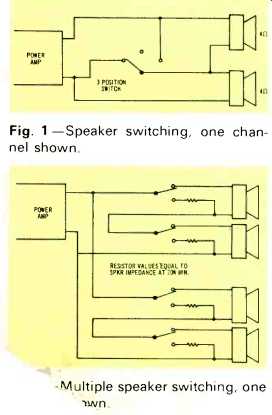How Many Speakers?
Q. My amplifier, a Kenwood KR7070, produces music power of 350 W. at 4 ohms output resistance, 260 W. at 8 ohms, and continuous power of 90 watts per channel at 8 ohms. How many speakers can I drive with this amplifier?
- Don Lauer, USN, FPO San Francisco, Calif.
A. There is no way of stating definitely how many speakers a given amplifier will drive. If the impedance of the speakers is 4 ohms, you may be able to drive just one pair. The reason for this is that power amplifiers do not like to be loaded below 4 ohms. The only way to overcome this problem is to connect the speakers in series. The speakers which are not needed at any given time can be shorted out by closing a switch which shunts each one. See Fig. 1 This arrangement will enable you to use two speakers per channel. Their combined impedance will be 8 ohms, well within the capabilities of the amplifier.

Fig. 1--Speaker switching, one channel shown. Fig. 2--Multiple speaker
switching, one shown.
Another limitation as to the number of speakers which can be successfully driven is speaker efficiency and the amount of power required to produce the listening level desired. If you plan to do lots of loud listening-such as would be involved with rock or perhaps organ music-you will not drive too many speakers because there will not be enough power to do so. Of course, if the speakers are more efficient than the average bookshelf unit, you can drive more of them. Horn speakers are quite efficient and you can, by series parallel connection, drive at least four of them per channel and have loud levels.
The wiring arrangements for this are shown in Fig. 2 If the speakers used are 4 ohms each, then the resistors shown must be 4 ohms each. If they are 8 ohm speakers, the resistors must be 8 ohms each, 20 W minimum power rating. The resistors serve to maintain a constant load, thereby keeping output level constant, regardless of the number of speakers switched into the circuit. Each individual speaker or pair of speakers is fitted with its own switch. These switches can be mounted at the speaker sites or they can be all grouped together on a single panel.
It's best to use make-before-break switches. While no pads were shown, they could be installed between the speaker and the rest of the circuit. They could then be used for adjustment of volume at the particular speaker location.
Remember that inefficient speakers may eat up enough power that you cannot drive more than two of them per channel. In fact, one per channel could be your actual limit if your listening levels are extreme and the efficiency is low.
Another factor we have not considered is the listening room in which the speakers are to be housed. In a room containing many pieces of furniture and heavy drapes the amplifier must supply a greater amount of power than would be required in a room where there are a lot of reflecting surfaces. This, of course, will limit the total number of speakers which can be driven by the particular amplifier.
Background music demands very little power for each speaker. Therefore, you will be able to drive a rather large number of speakers, even where they are not efficient. Of course, they must be wired in such a manner that the amplifier does not look into an impedance of less than 4 ohms.
Acoustic Feedback
Q. My problem is "acoustic feedback." My speakers are wall-mounted on wooden shelves with thick foam rubber between the speaker cabinets and the shelf. The turntable is mounted on three-inch foam rubber.
Because the whole system is in a small room, I am forced to turn the bass controls up slightly passed "flat." It is impossible to compensate for any records which might be deficient in bass without “blowing the cones right out of the cabinets." The turntable is located on a heavy, low chest of drawers. I do not want to change the location of my equipment as it sounds fine and is convenient where it is. I simply want to get rid of the “acoustic feedback. "
-Frank V. Marsicovetere, Jr., Staten Island, N.Y.
A. Your acoustic feedback problem may be difficult to correct. If the sound is conducted through the air, foam will not be sufficient. You must separate the turntable and speaker by a greater distance than you now have them. Most of the time, however, sound is conducted by way of structure floors, walls, etc. Foam will be effective if you find the right combination of thickness and density.
I suggest a minimum thickness of two inches. However, if the speakers are heavy enough to completely collapse the foam, it will serve no function, since the speakers will be effectively resting on the shelf. On the other hand, if the density of the foam is such that the speakers rest on it, without sinking in at all, the foam will still not act as an isolator. What you need is a foam which is a happy medium. The speakers should sink down into it, perhaps half the total thickness of the foam. You should be able to press lightly on top of the speakers and observe they sink further into the foam. Then the speakers are isolated. They can be compared to an object floating in water.
The mounting arrangements for the speakers also hold for the turntable assembly. However, in the case of the turntable, I have found that the structure on which it rests should be extremely solid. Placing a piece of heavy equipment on this same structure often serves to damp out vibrations.
(Audio magazine, May 1972, Joseph Giovanelli)
= = = =